How to See the Best of Lisbon in Two Days

Day 1, Explore the Tagas River, Alfama, Baixa and Barrio Alto
Portugal is fascinating! The Romans, Visigoths and Moors all spent time occupying the country and left their mark on its architecture and culture. In the 15th and 16th centuries intrepid Portuguese explorers sailed the world leading immense wealth. These riches resulted in the construction of stunning cathedrals, castles and monasteries. All this considered, I was ready to go! My husband and I looked at various trips and decided on a Viking Douro River Cruise.
The first part of the Portugal Viking trip begins in a Lisbon hotel not on the Douro river. Believe me, it is a treat to have two days and two nights in Lisbon! We took off from Philadelphia at 9:30 pm and arrived at 9:30 am the next day. Two Viking greeters dressed in their iconic red shirts met our recently arrived group. We boarded a Viking bus and rode to the luxurious Hotel Tivoli. Our room wasn’t ready, but the hotel secured our luggage and delivered it to our room later. The map below shows the districts most people like to visit.
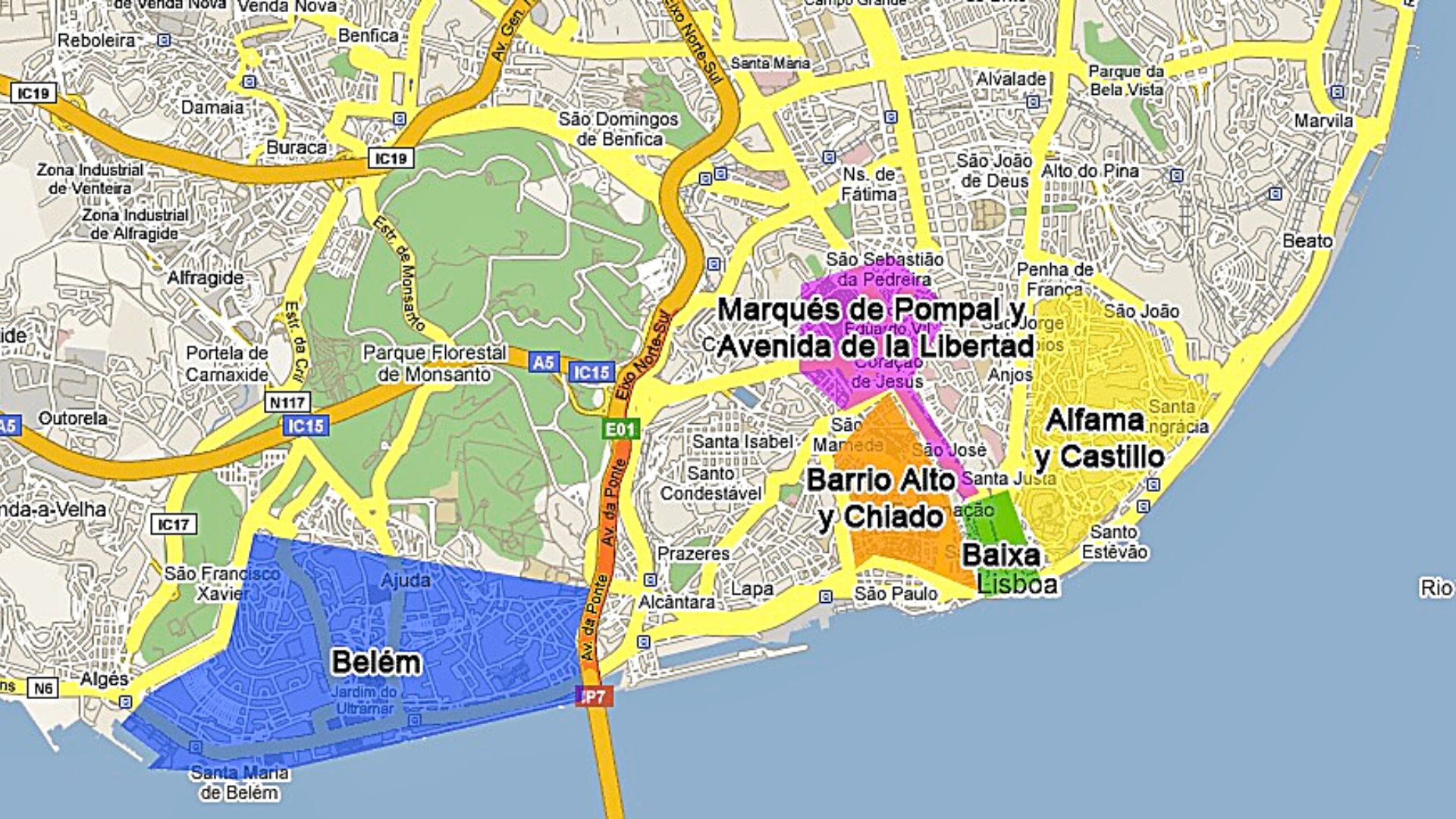
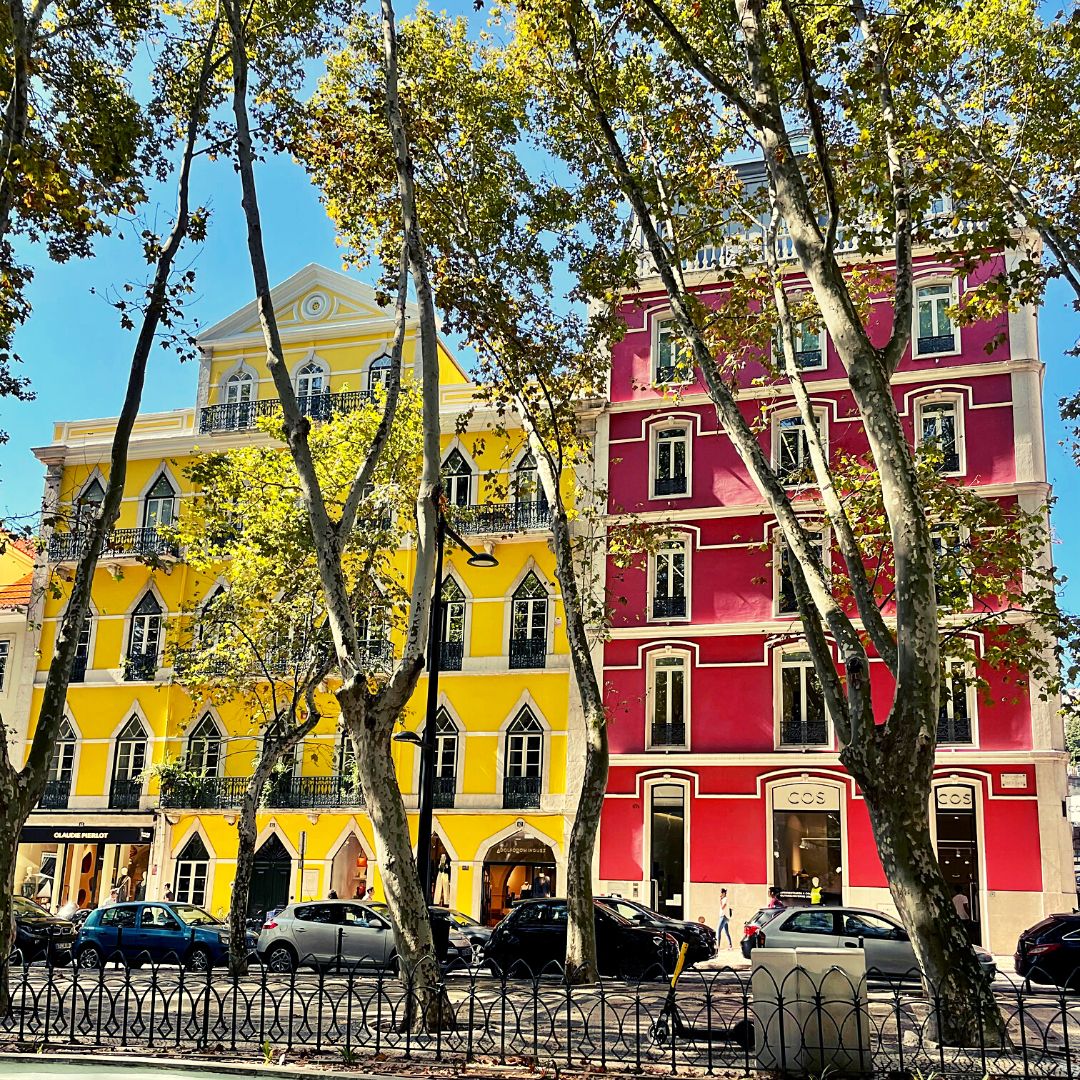
Hubby and I traveled with another couple from Wilmington. We’ve been friends for years and had done a previous Viking River Cruise together. I highly recommend going with another couple. There is a bit of down time on these river cruises – time on a bus and time on the ship. There’s also some instances where there’s the opportunity to explore towns on your own. During that time, I like to do a little shopping, hubby not so much. I was glad I had a friend with whom to check out the stores. Both hubbies were happier finding a museum (or bar) instead.
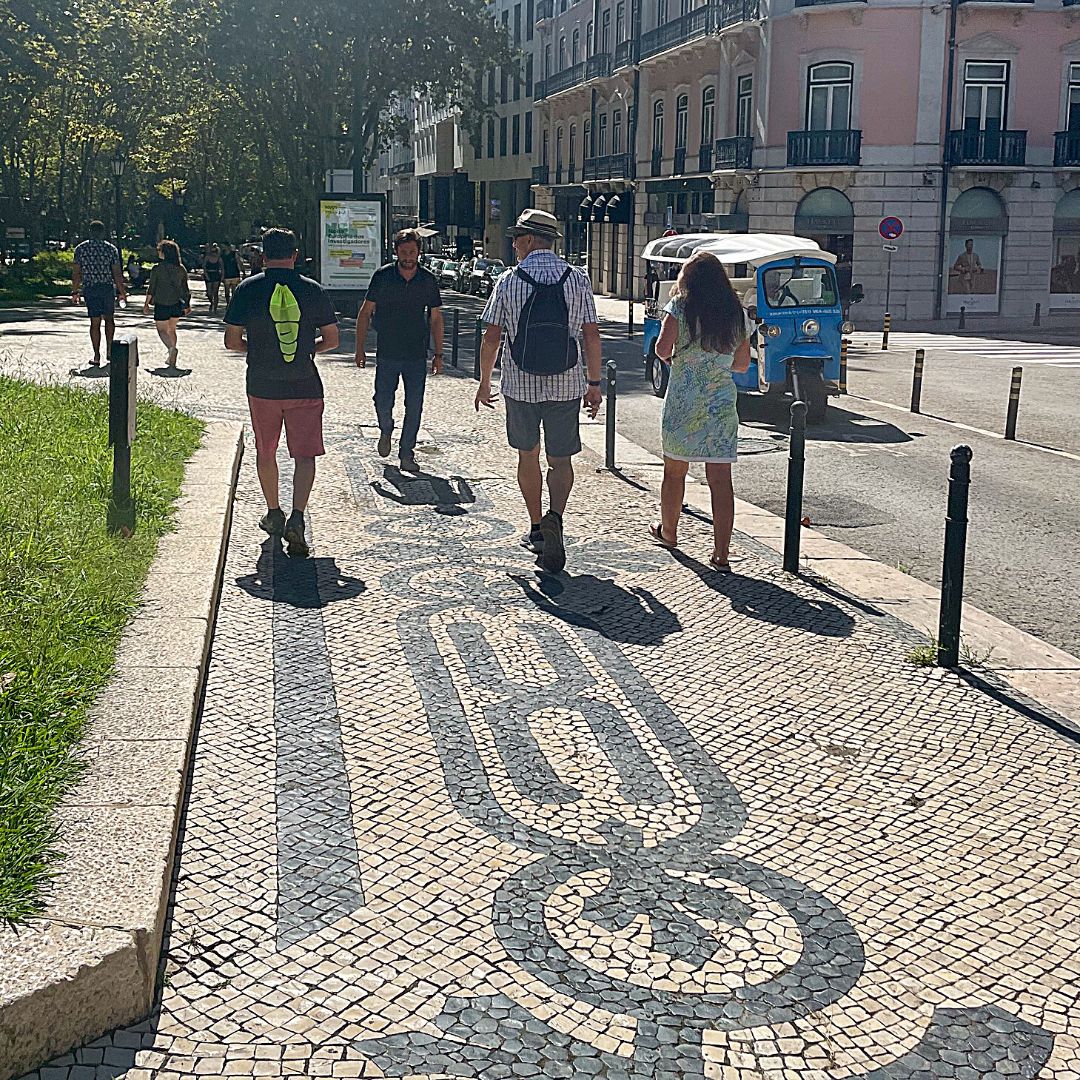
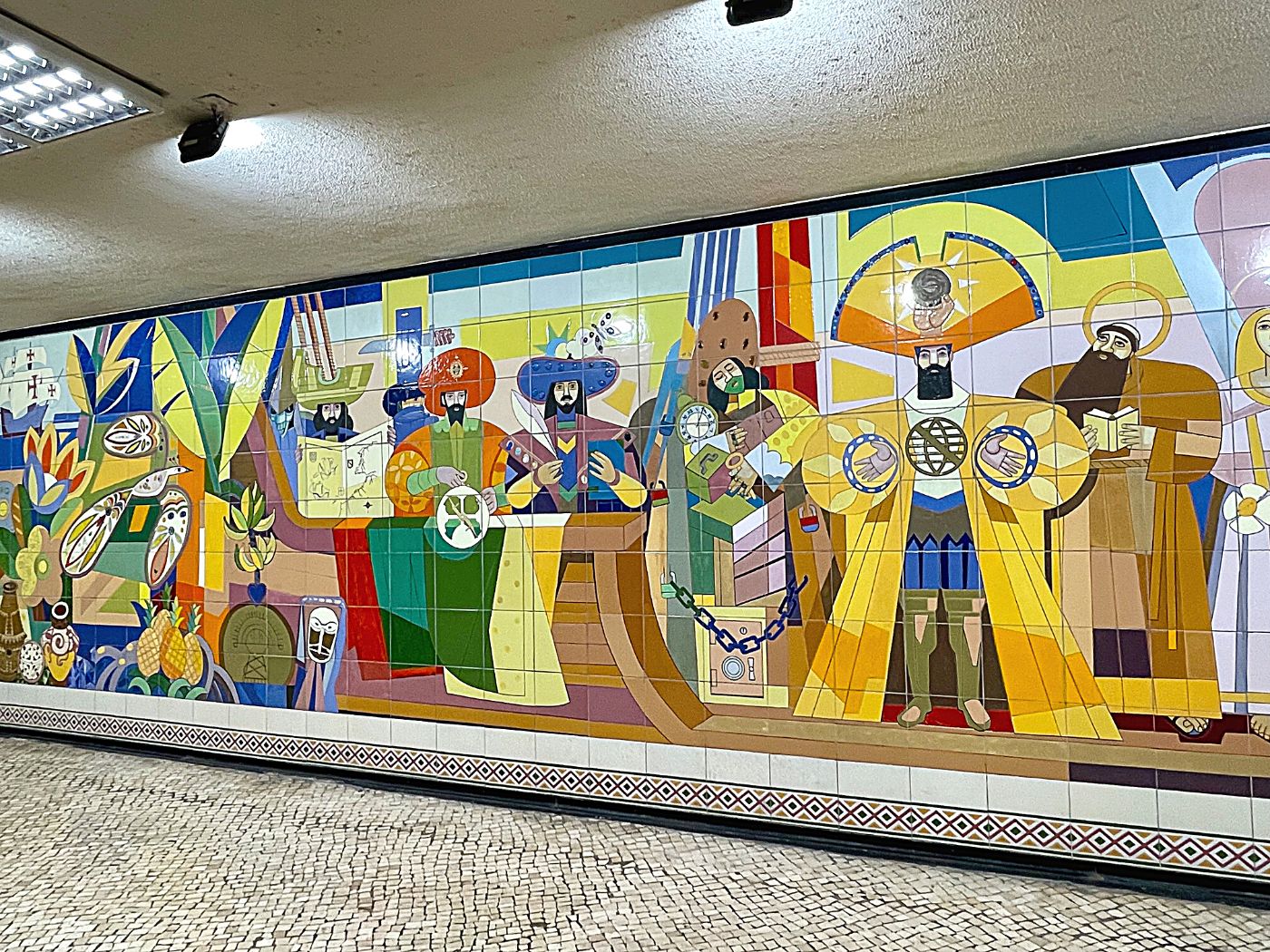
We had about 5 hours before a group orientation meeting with the Viking Program Director. Plenty of time to visit some must see sites! First up lunch at the Time Out Market which was walkable from the hotel. Our route took us down Avenida da Liberdade to Restauradores Square, a busy intersection. We took the Metro Station underpass to avoid the traffic. A colorful tile mural celebrating the Portuguese explorers arrival in Brazil was my first sighting of Portuguese azulejos. Many Lisbon metro stations have artistic tile-work, a modern form of the azulejos tradition.
When we returned above ground we passed one of Lisbon’s three funiculars, the Ascensor da Glória. Lisbon is built on seven hills. The funiculars are a unique way for people to travel up and down between neighborhoods. They are included in the city’s transportation pass.
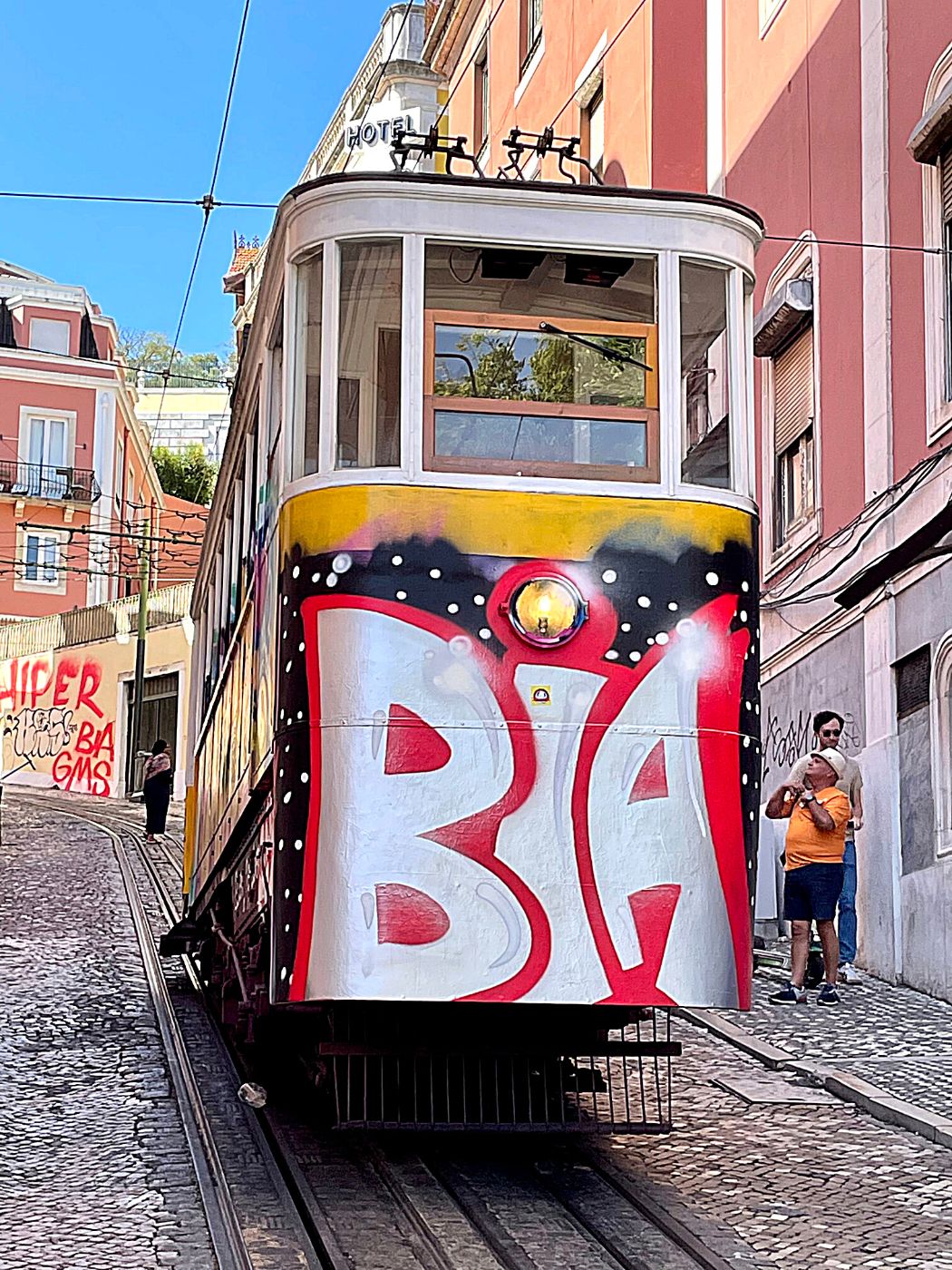
The funicular car had been used as an artist’s canvas. Heads up, there is a lot of graffiti in Portugal. Some of it is intriguing, even beautiful and some of it is not. If you’re a fan of street art click here to see a great post about where to see Lisbon’s best urban art.
Further down the road, we spotted Santa Justa Lift’s lower level. The seven story, iron Santa Justa Lift offers another way to travel up one of Lisbon’s hills. The intricate gothic details are cathedral-like. The elevator is a top tourist attraction and only holds a small number of people. If you have your heart set on experiencing this, do yourself a favor and take the lift down from the Carmo Convent location. It’s way less crowded. There’s also a viewing platform above the elevator that provides a terrific view!

We continued to meander to our lunch destination and walked through Municipal Square. Seeing an entire plaza covered in a triangular black and white cobblestone pattern was jaw-dropping! The Calçada are underfoot all over Lisbon. They can be a little tough to walk on – wear comfortable shoes! They are the topic of a current safety/repair cost/art debate. Are they worth it to maintain? I sure think so! You can learn more about Calçada Portuguesa here.
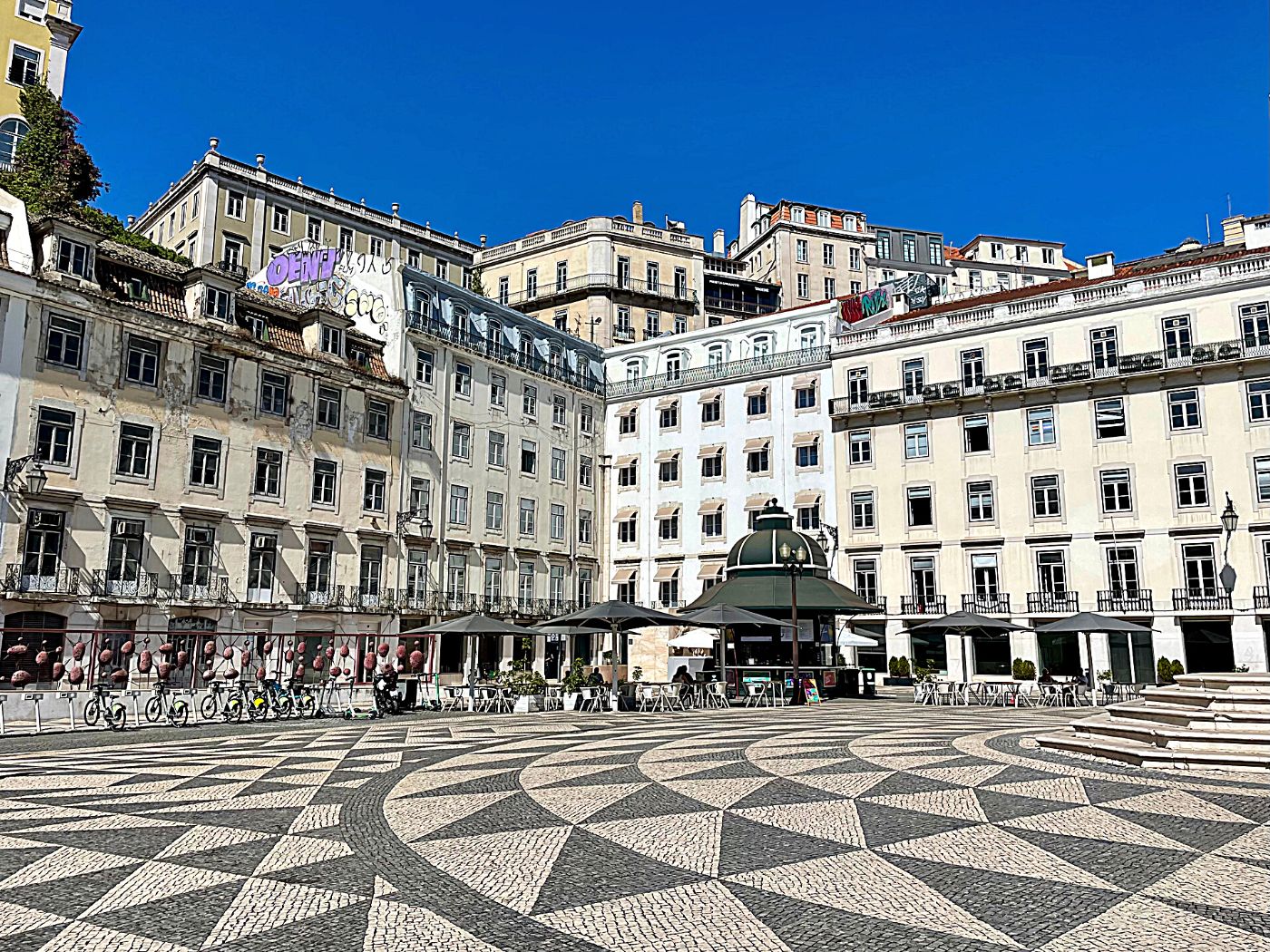
We finally arrived at the Mercado de Ribeira’s Time Out Market. It opened in 1882 and served for years as Lisbon’s wholesale meat and produce market. The market was redesigned in 2014. Time Out Magazine won the contract and added an upscale food court. Don’t confuse this with the US shopping mall food courts. The iron and glass industrial architecture is attractive.
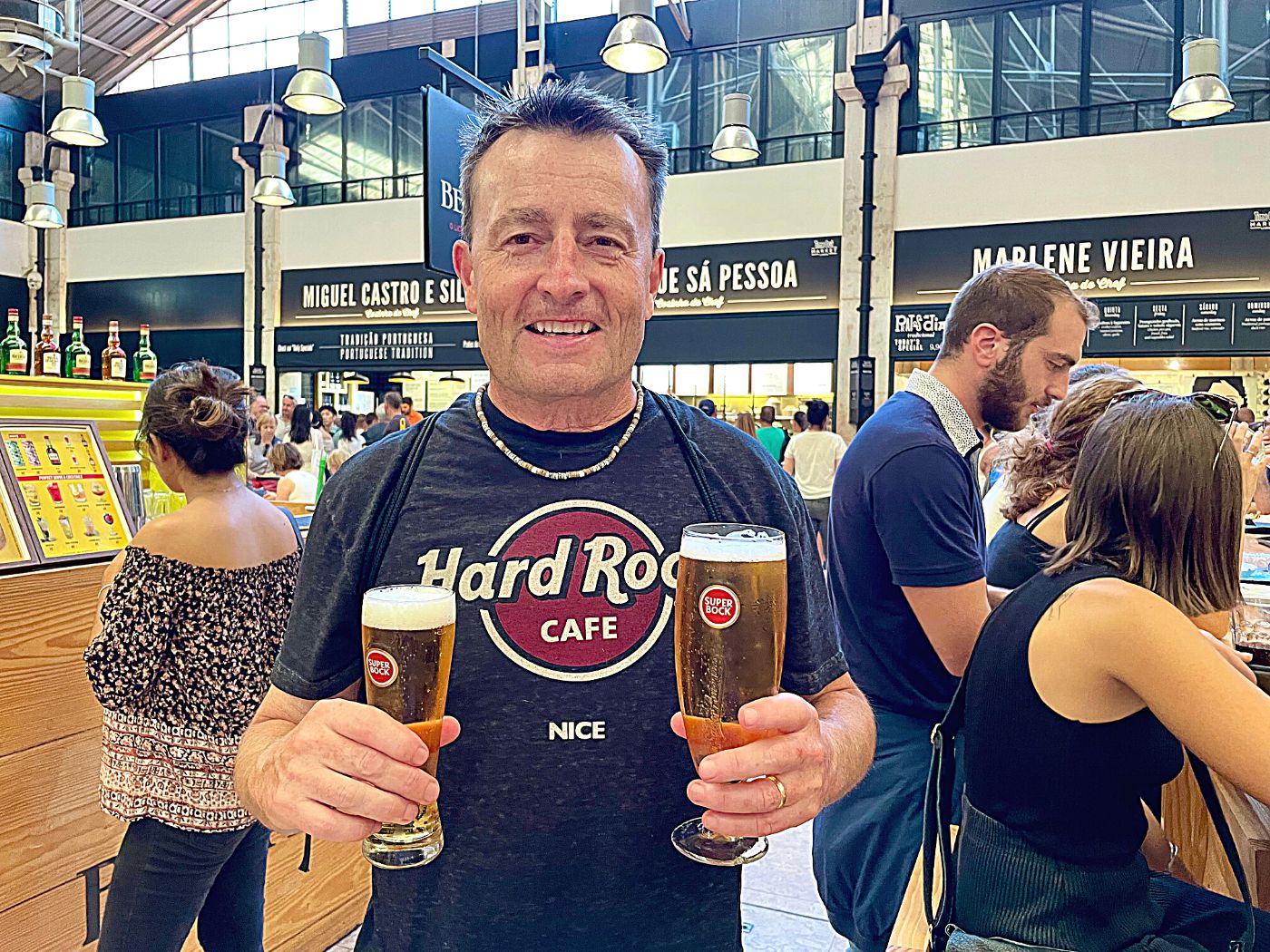
Restaurant stalls are located around the perimeter. Some booths offer food from highly regarded Portuguese chefs like Silva and Sá Pessoa. Beverages including alcohol are available in the center. Long, communal tables are situated in between the food and drink. The four of us ordered at different restaurants and were given pagers to let us know when the food was ready.
The Time Out Market is located in the São Paulo District near the waterfront. After lunch, we headed to the river and saw the Abril 25 Suspension Bridge. It’s the same design as the San Francisco Golden Gate Bridge and is made by the same US company. The Cristo Rei, watches Lisbon from across the river. It was inspired by Brazil’s Christ the Redeemer statue. The monument has a viewing platform you can visit. As you probably know, Brazil has ties to Portugal. Explorer Pedro Alvares Cabral landed there in 1500 and claimed the resource-rich country for the Portuguese Empire.
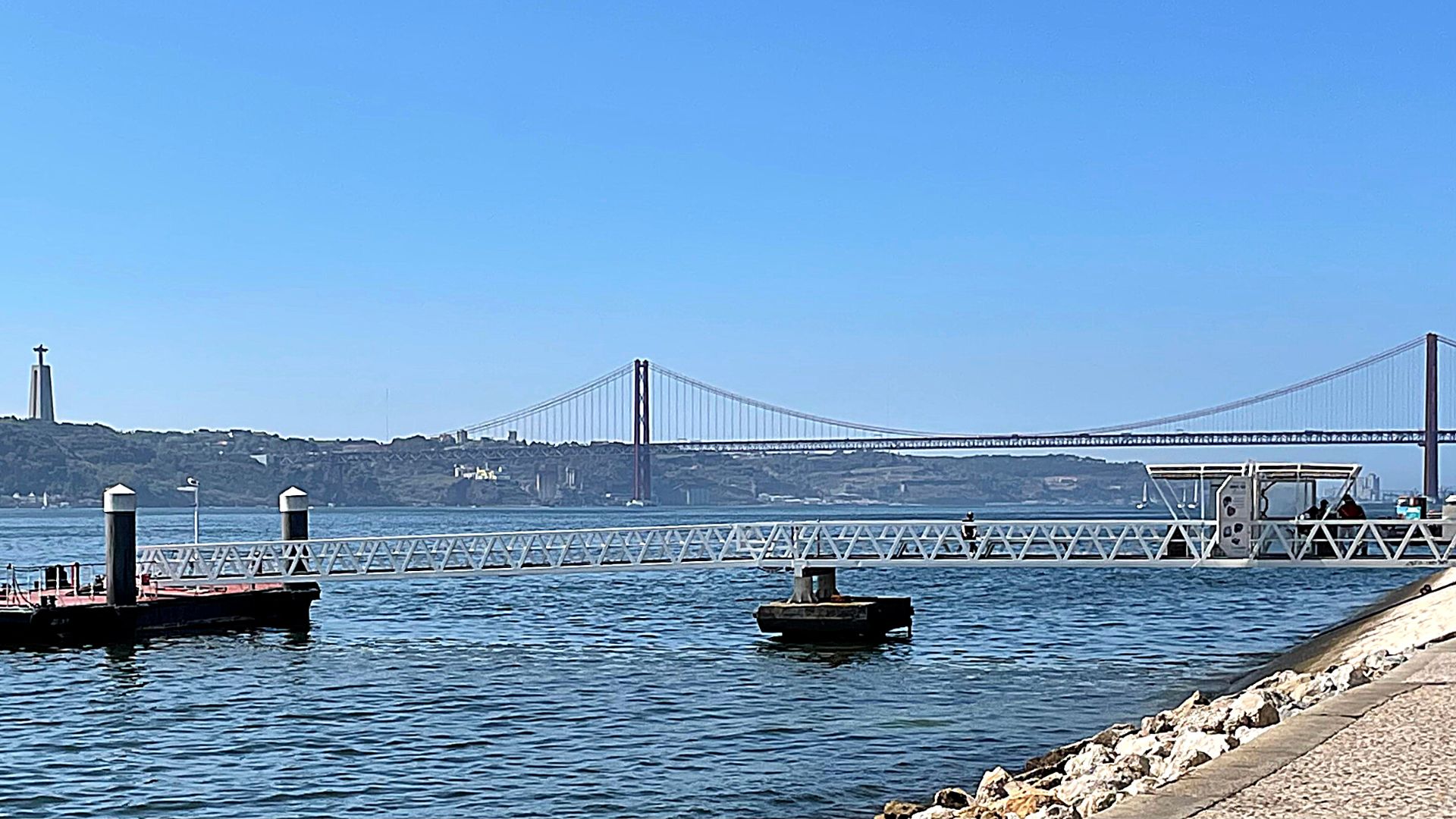
From there we walked along the water to Commerce Square. This is one of the most instagrammable spots of Lisbon. The sunshine yellow buildings contrast so beautifully with a blue sky. That stunning combo of blue and yellow is repeated all through Lisbon and makes for some artsea photograph opportunities.
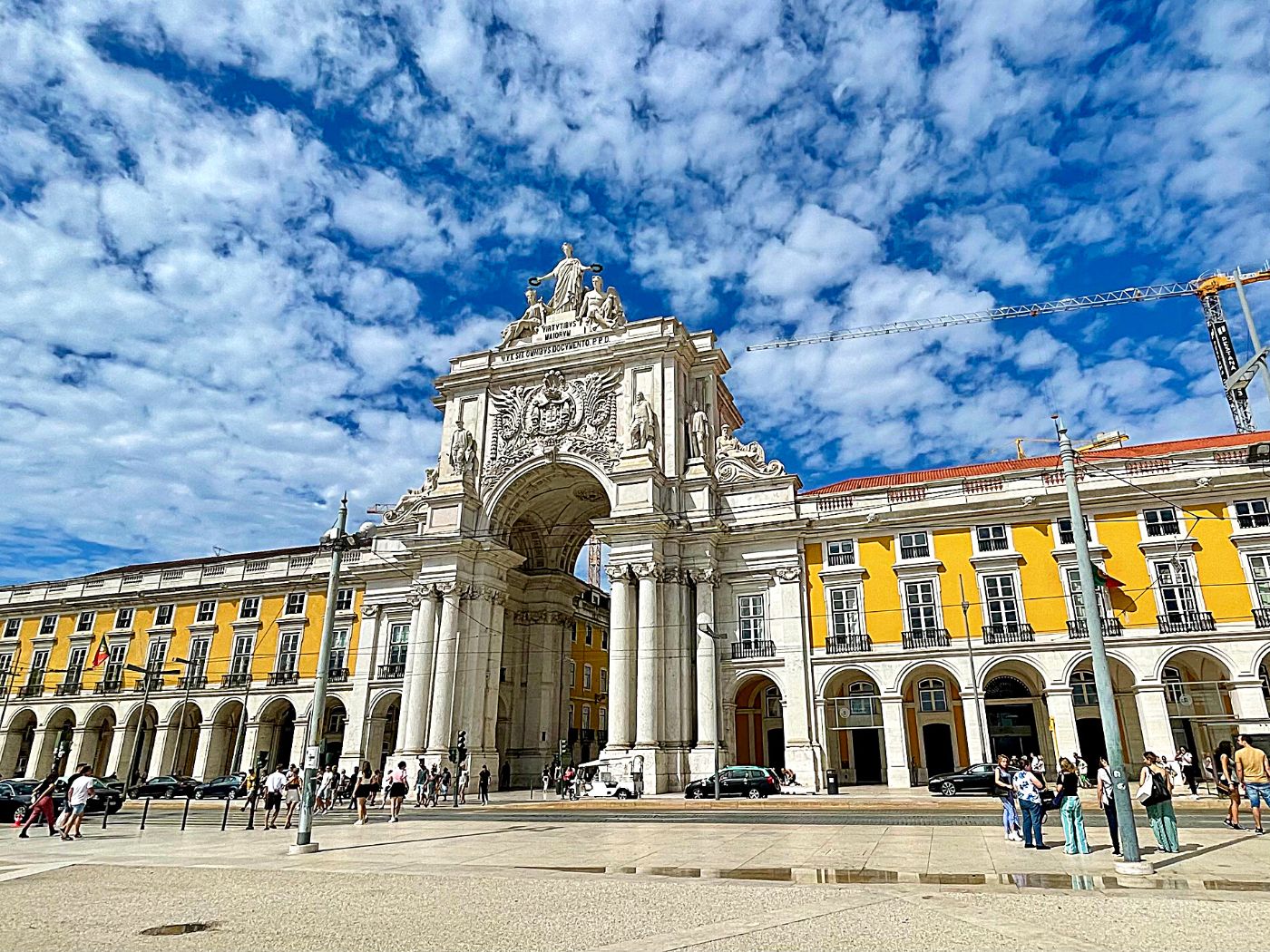
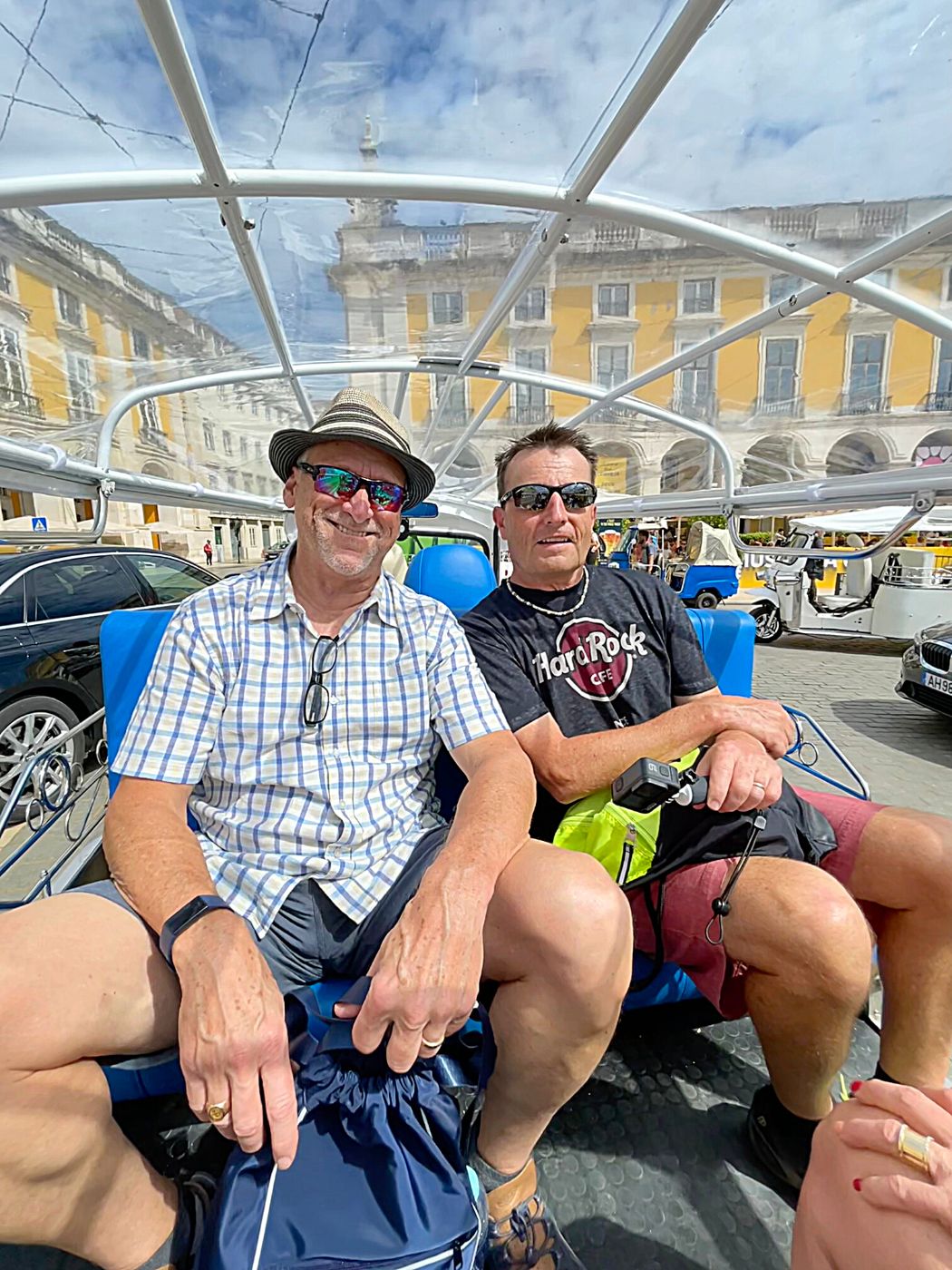
We caught a Tuk Tuk to make the Alfama climb. It cost €5 each and was a fun way to see the Lisbon streets.
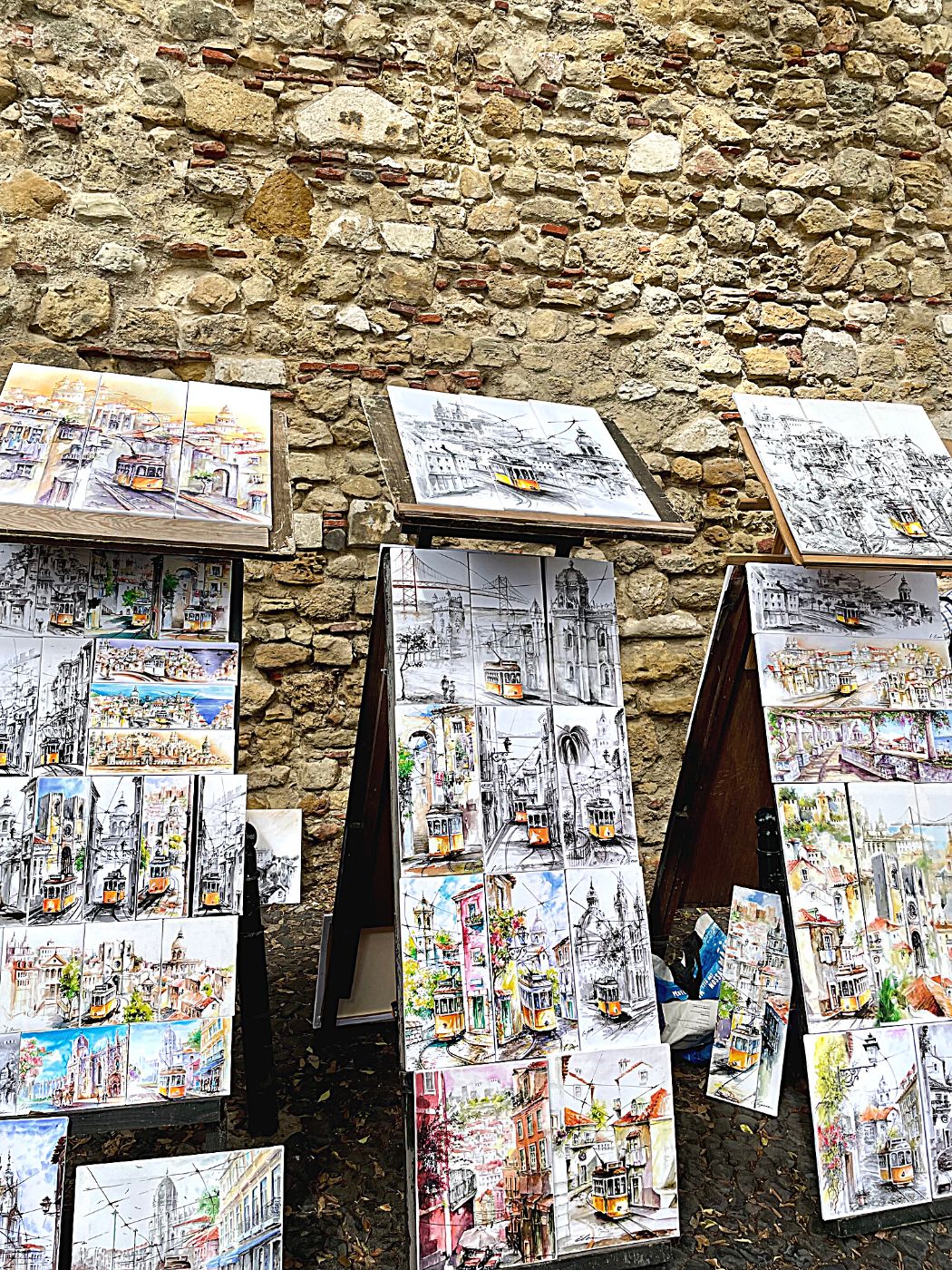

The Tuk Tuk dropped us at the São Jorge castle’s entry gate. With our time constraint we chose not to tour it. To me, the best part about the castle is the fairytale view of its hilltop ruins from elsewhere in Lisbon.
On our walk down we wanted to see the Portas do Sol view. My best advice is to wander the Alfama labyrinth and enjoy the surprises along the way – old buildings covered with glazed tiles (azulejos), clothes drying on the line between windows and if you’re lucky, the melancholy sounds of Fado music. The miradouro (overlook) was one of our favorite spots of the day – check out this post’s first photo.
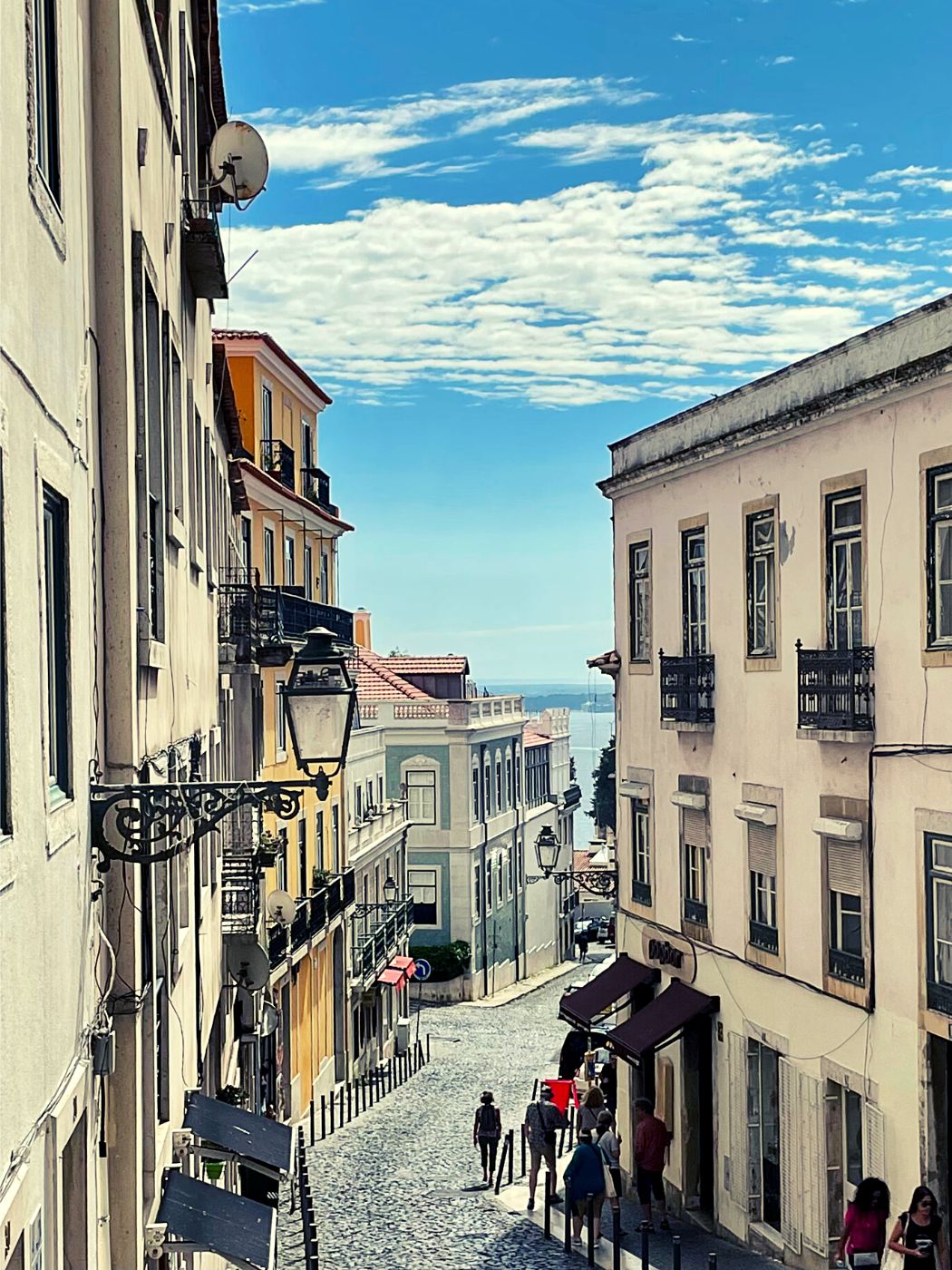
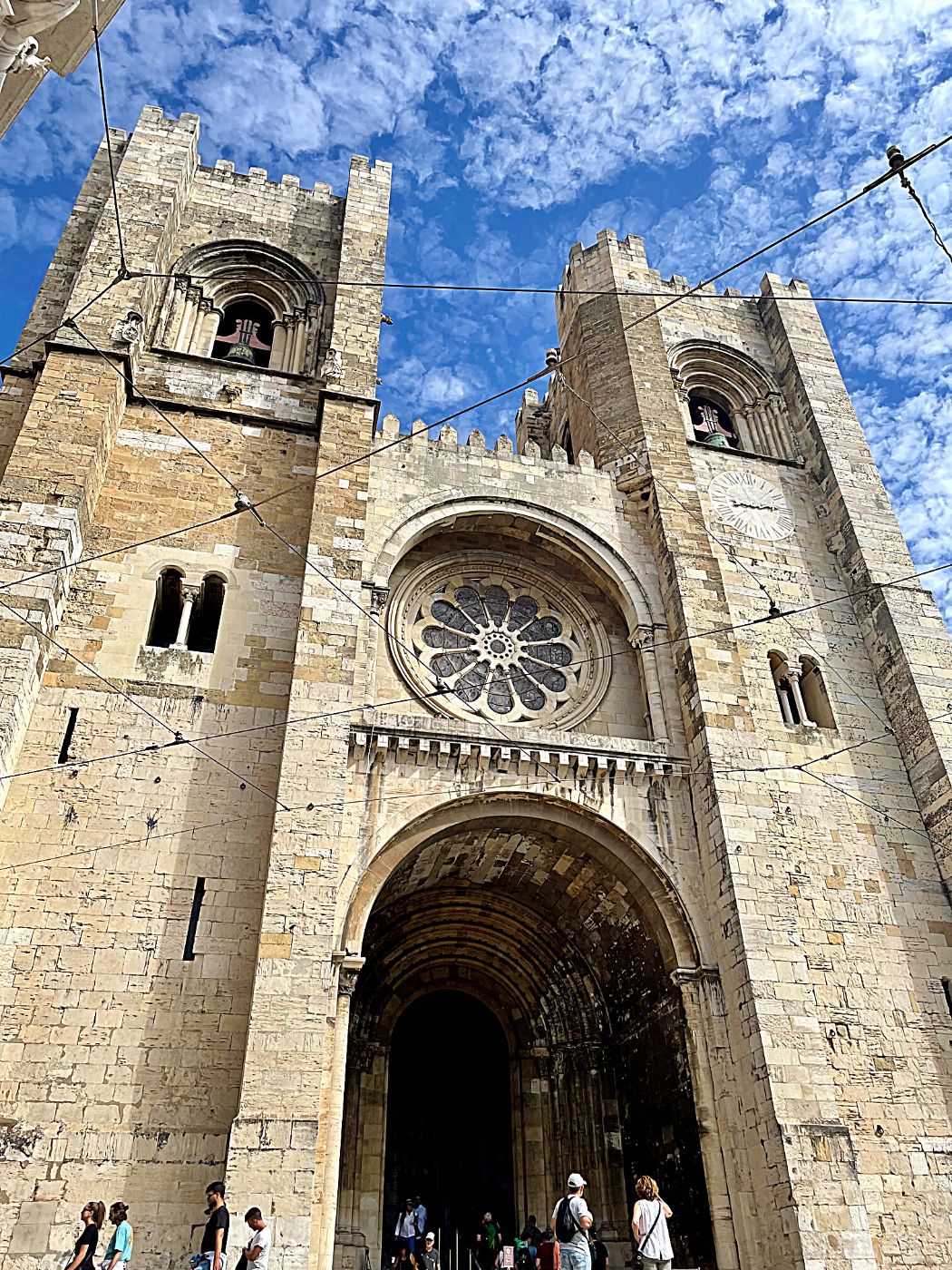
Next place on our Lisbon best sites scavenger hunt was the Pink Street. On the way we passed through the Julio de Castilho Garden and by the Lisbon Sé. Built in the 12th century, the cathedral is one of Lisbon’s oldest buildings. The Rua Augusta, a happening pedestrian street, appeared next. One side ends with a great view of the Arco Augusta. There was scaffolding interfering with the popular photo op, but the other side is also engaging.
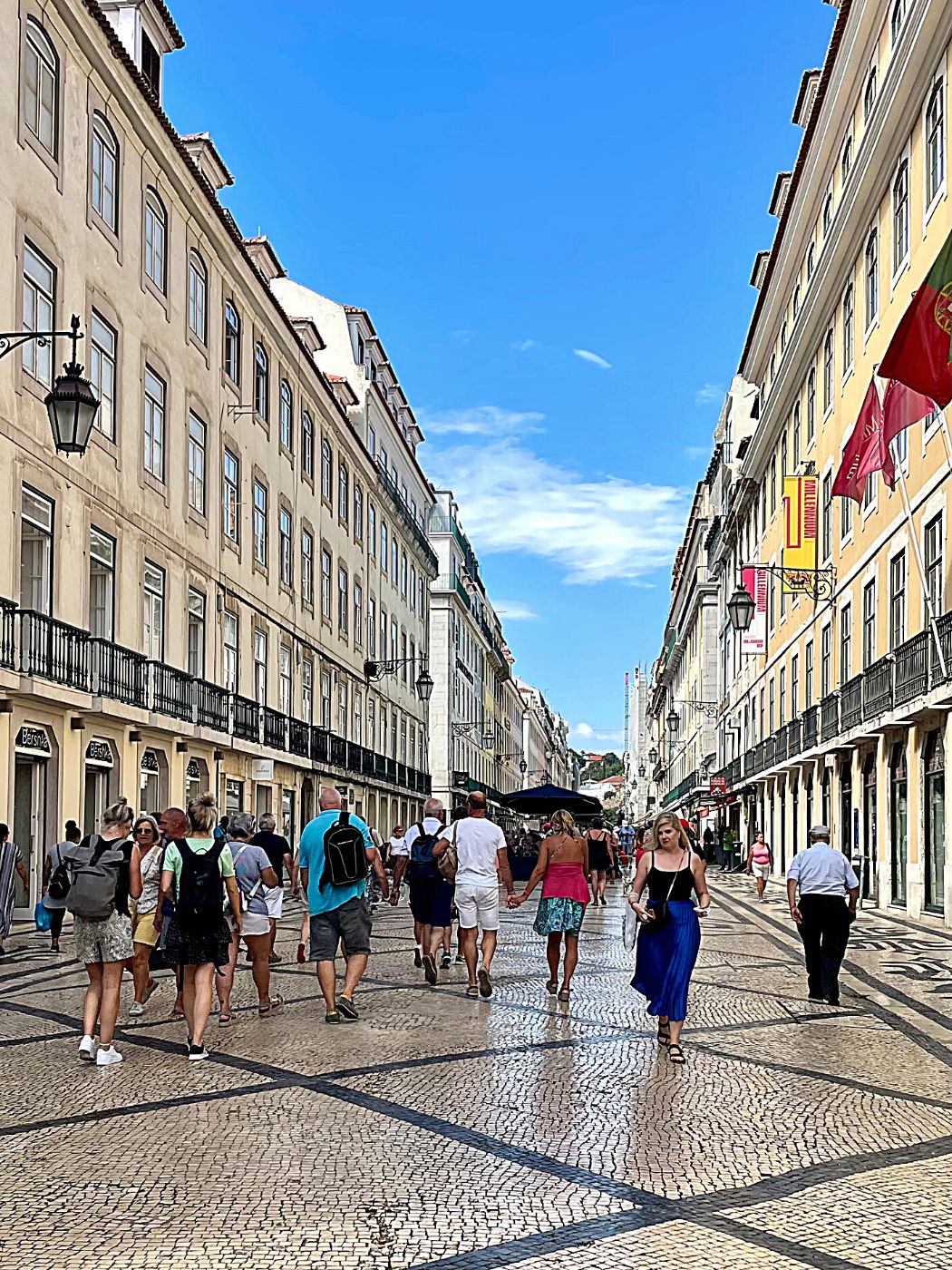
We had worked up a thirst and ducked into Agora Cafe at the corner of Rua do Alecrim and Rua do Ferragial. We met a super nice US ex-pat who told us many positives about living in Lisbon and she gave us good walking directions to the Pink Street.
The Pink Street is the result of a 2013 urban renewal project in an area that used to be known as the red light district. It’s a unique place for a photo and home to a pretty rocking section of Lisbon’s nightlife. Often art installations float overhead like the rainbow umbrellas seen in our insta-worthy shot.
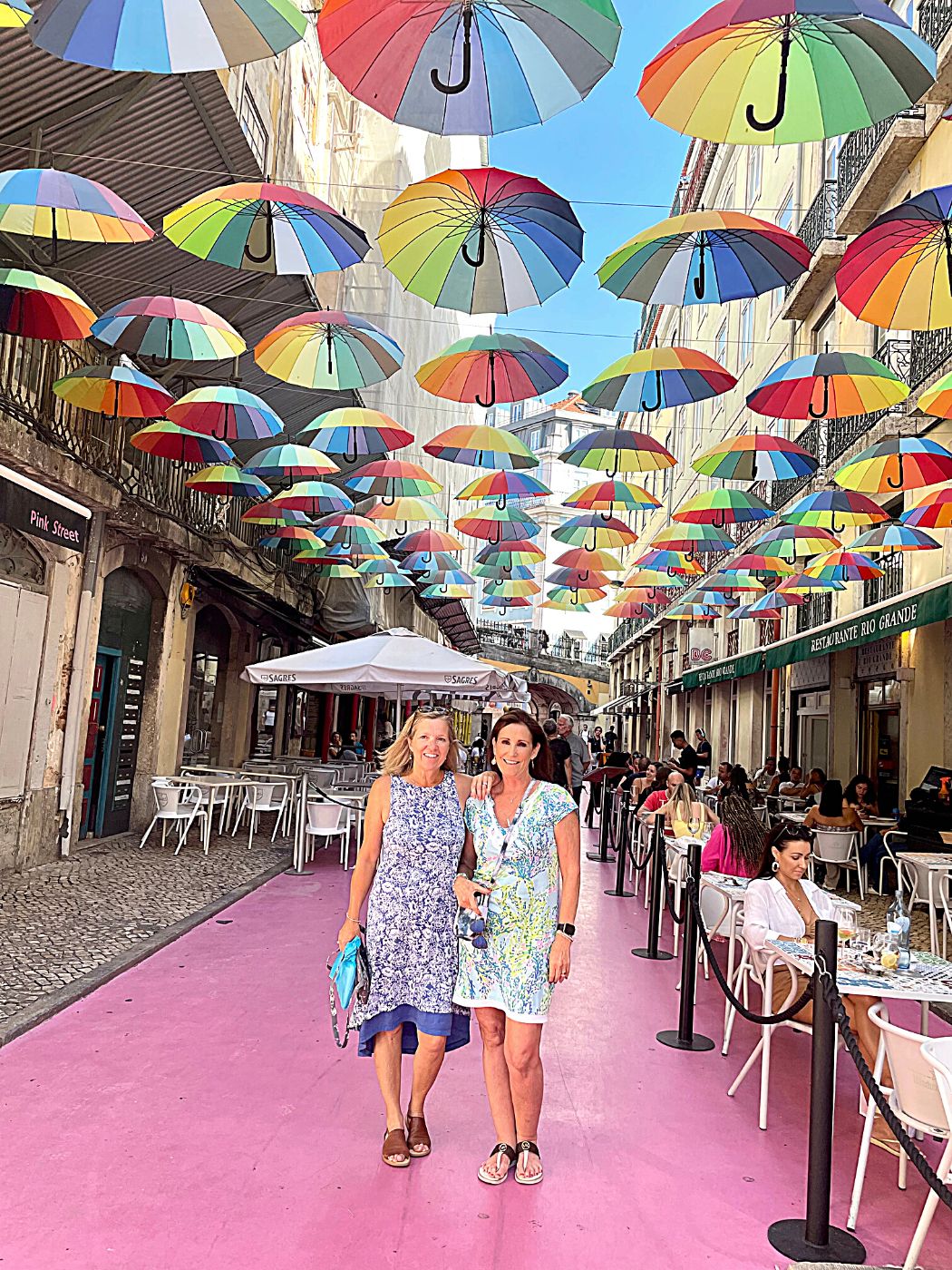
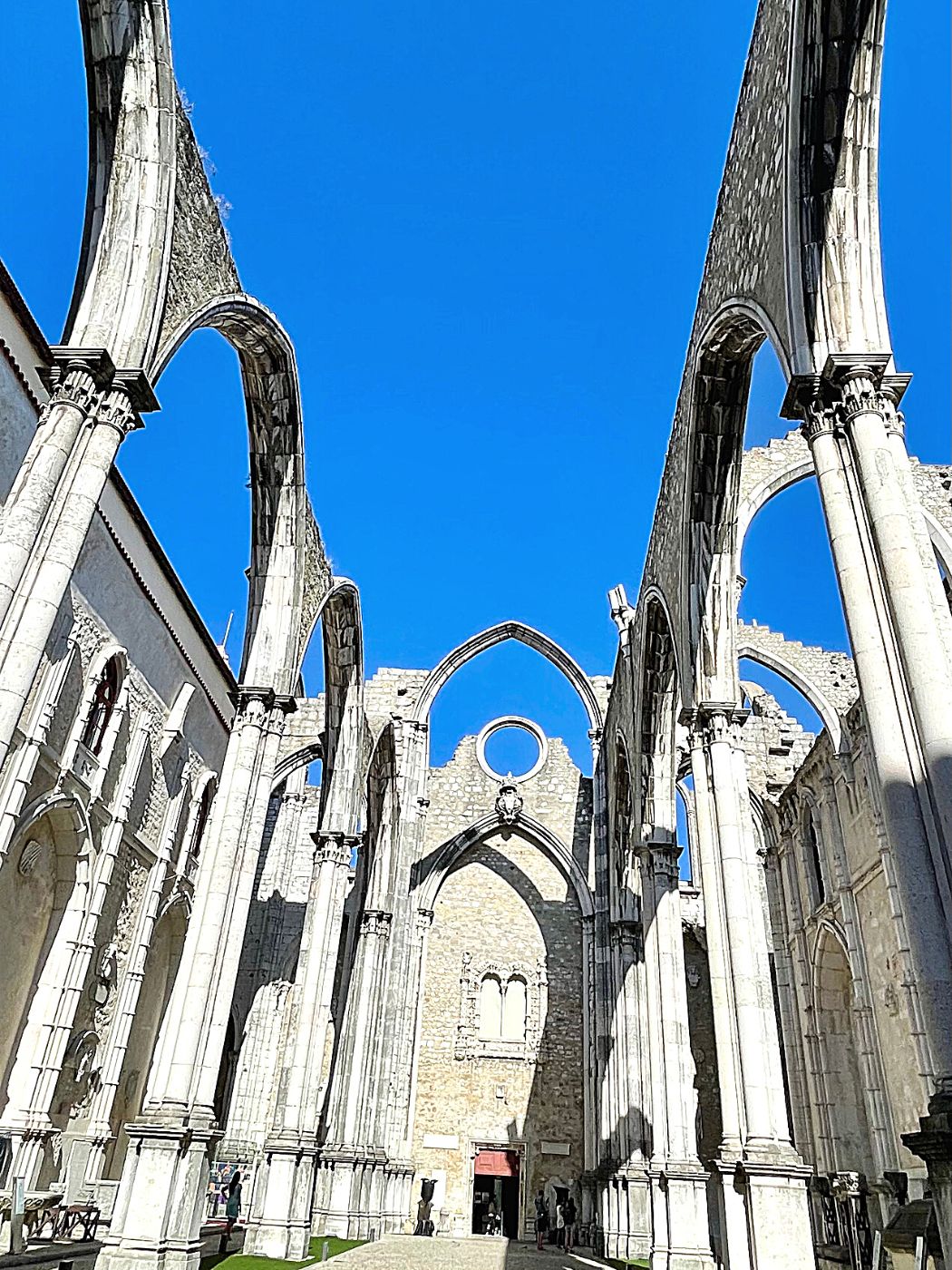
We found another available Tuk Tuk and went to the Carmo Convent. The 1755 Earthquake and following fire and tsunami flattened most of Lisbon. A horrific number of the population were killed, and precious buildings, books and artifacts were lost. The Carmo Convent ruins are a spectacular, eerie reminder of that terrible event. The epicenter was off the coast and seismologists today estimate the magnitude was between 8.5 and 9.0. The districts of Alfama and Belem had less damage. And that is why those two areas have Lisbon’s oldest surviving architecture.
In the reconstruction following the disaster, streets were widened and used grid organization, large open squares were added, and more seismically sturdy architecture was developed. The Rua Augusta Triumphal Arch was built in honor of Lisbon’s earthquake survival.
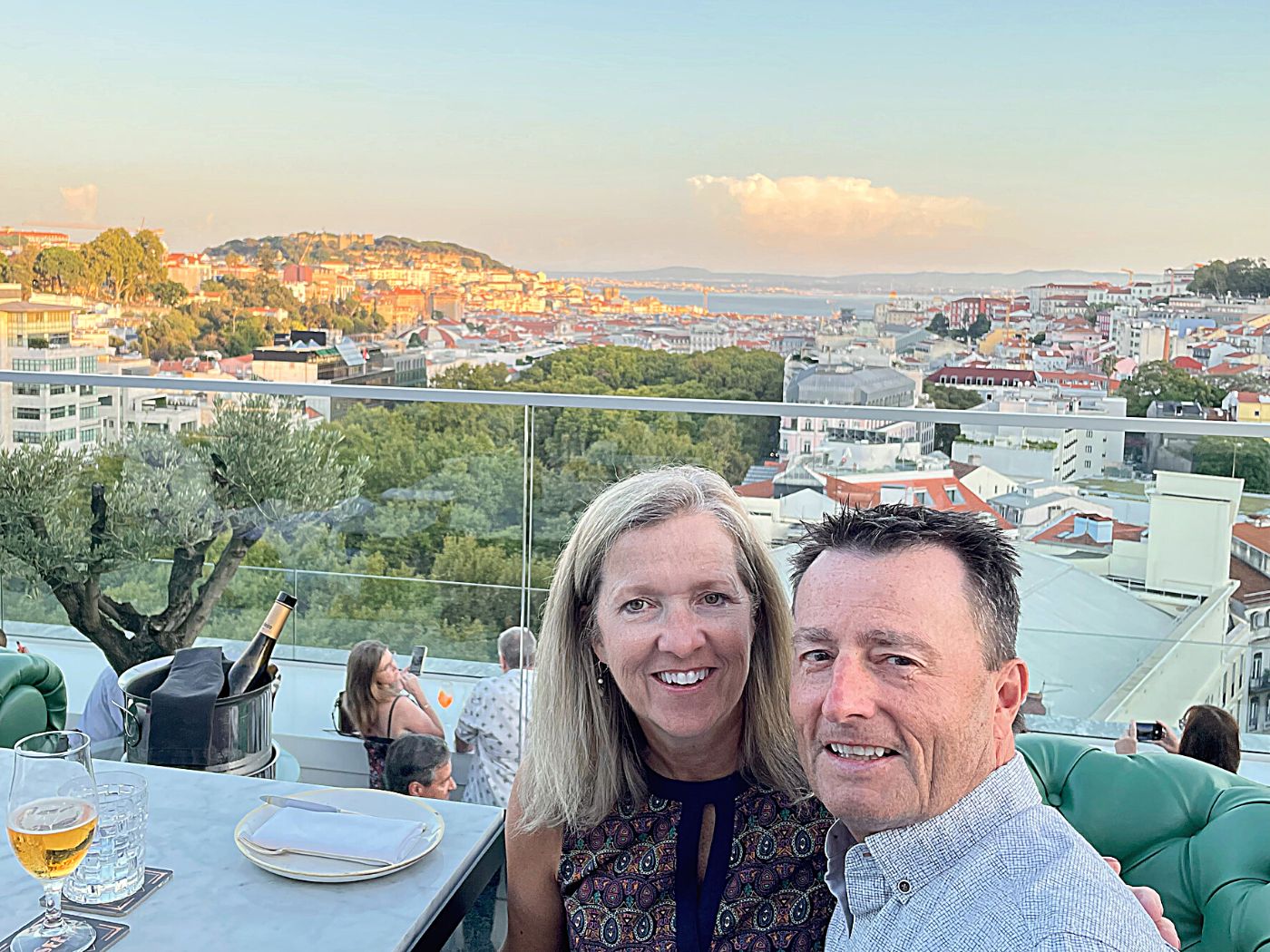
After our moving visit to Carmo, the long day of traveling and sightseeing caught up with us. We returned to the Tivoli Hotel and nabbed a last minute dinner reservation at Seen. Before dinner though, we attended the Viking Torgil Program Director’s informative talk.
At Seen the view, service and food were outstanding! I highly recommend the lobster salad – a unique dish of sweet lobster, slivered asparagus, avocado, caramelized onion and crispy truffle shavings. PS, it’s fancy and pricey. There is a dress code – no flip flops.
Day 2, Belem and Campo de Ourique

We started day two with a wonderful breakfast! The Tivoli spread of food was amazing and included an omelet station. We needed to request half and half for our coffee, as Europeans tend to prefer milk.
Viking buses were waiting out front to take us Torgil passengers to the Belem district. There are four Viking River Ships on the Douro; the Torgil and the Osfrid tour the Belem Tower and Jeronimos Monastery, while the Hemming and Helgrim tour the Maritime Museum and Jeronimos. We only walked around the Belem Tower’s exterior. The coach then drove past the Monument to the Discoveries (too hard to get a good pic from the bus) on the way to Jeronimos.

The Belem Tower and Jeronimos Monastery are examples of the unusual Portuguese Manueline Architecture. It’s ornate gothic style with nautical details like knots, rope, the Cross of Christ and the armillary navigational sphere.

We began our guided Jeronimos tour with the stunning cloisters. A monastery’s cloisters typically join different buildings with a covered breezeway. Columns, high vaulted ceilings and open arches let in lots of light.
After the cloisters there are a few options for the Viking group. You can wait in line with your Viking tour guide to go through the Santa Maria de Belem Church, you can walk to the Monument to the Discoveries, or you can wait in a different long line to order a Pastal de Nata at the Belem bakery where the yummy egg custard tart originated.
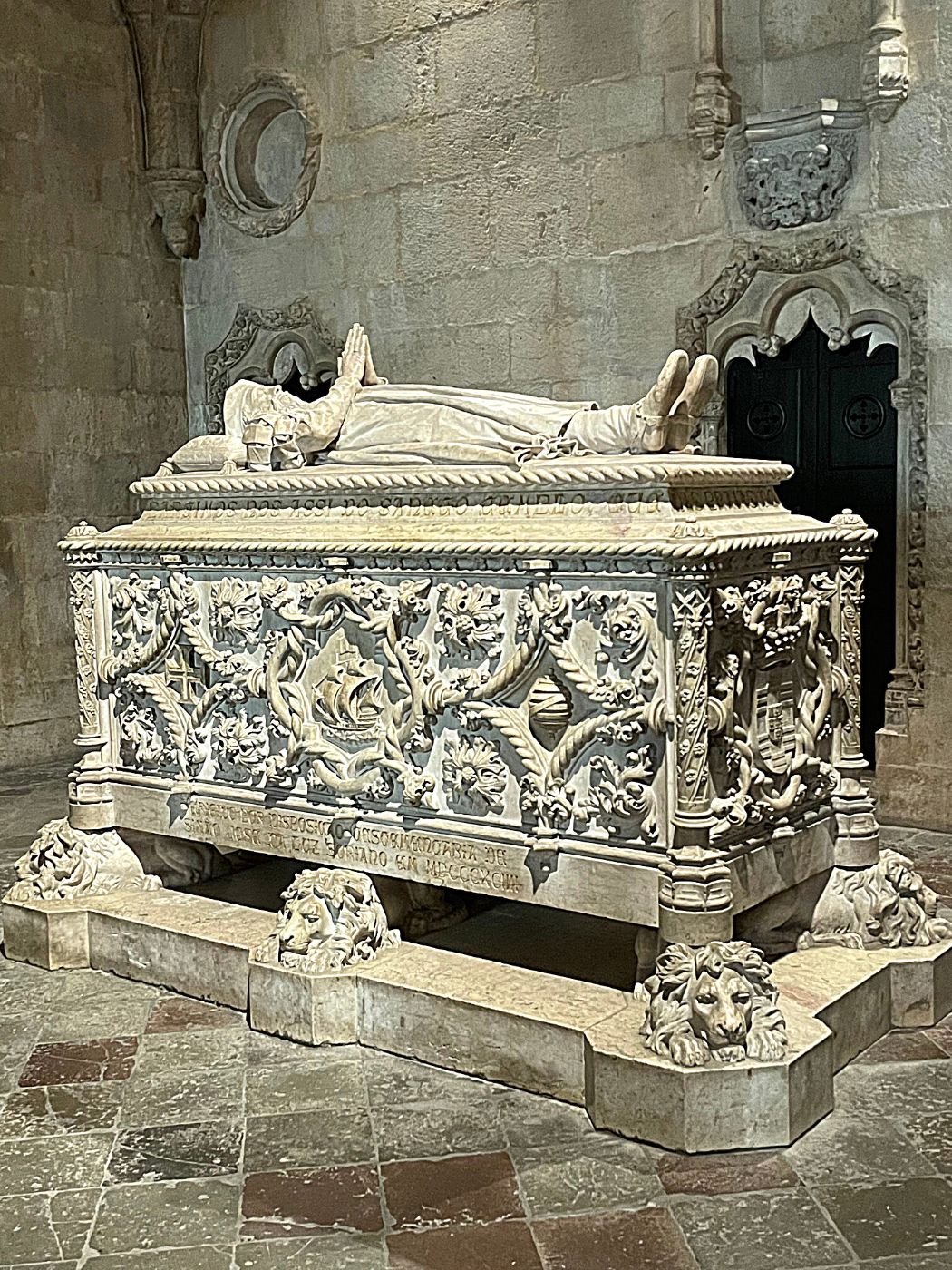
Having only caught a quick glimpse of the discoveries monument, I think the walk there and views of the river, bridge and monastery would have been the best use of our time. Plus, it was a gorgeous day outside. But, we chose to see the church. It does have an impressive multi-level ceiling where the vaulting comes together and looks like a spiderweb. I failed to get a good picture in there. Hoards of tourists were in every corner.
Jeronimos is definitely deserves its UNESCO World Heritage Designation. If you’d like to take a deeper dive into its history and see additional beautiful photos click HERE.
We boarded the bus back to the hotel, but first it stopped at Parque Eduardo VII. We realized that the park was fairly close to the hotel and decided to walk rather than take the bus. Viking is accommodating when you want to break off on your own. We stopped at a lovely sidewalk cafe, Rubro Avenida for some tapas.
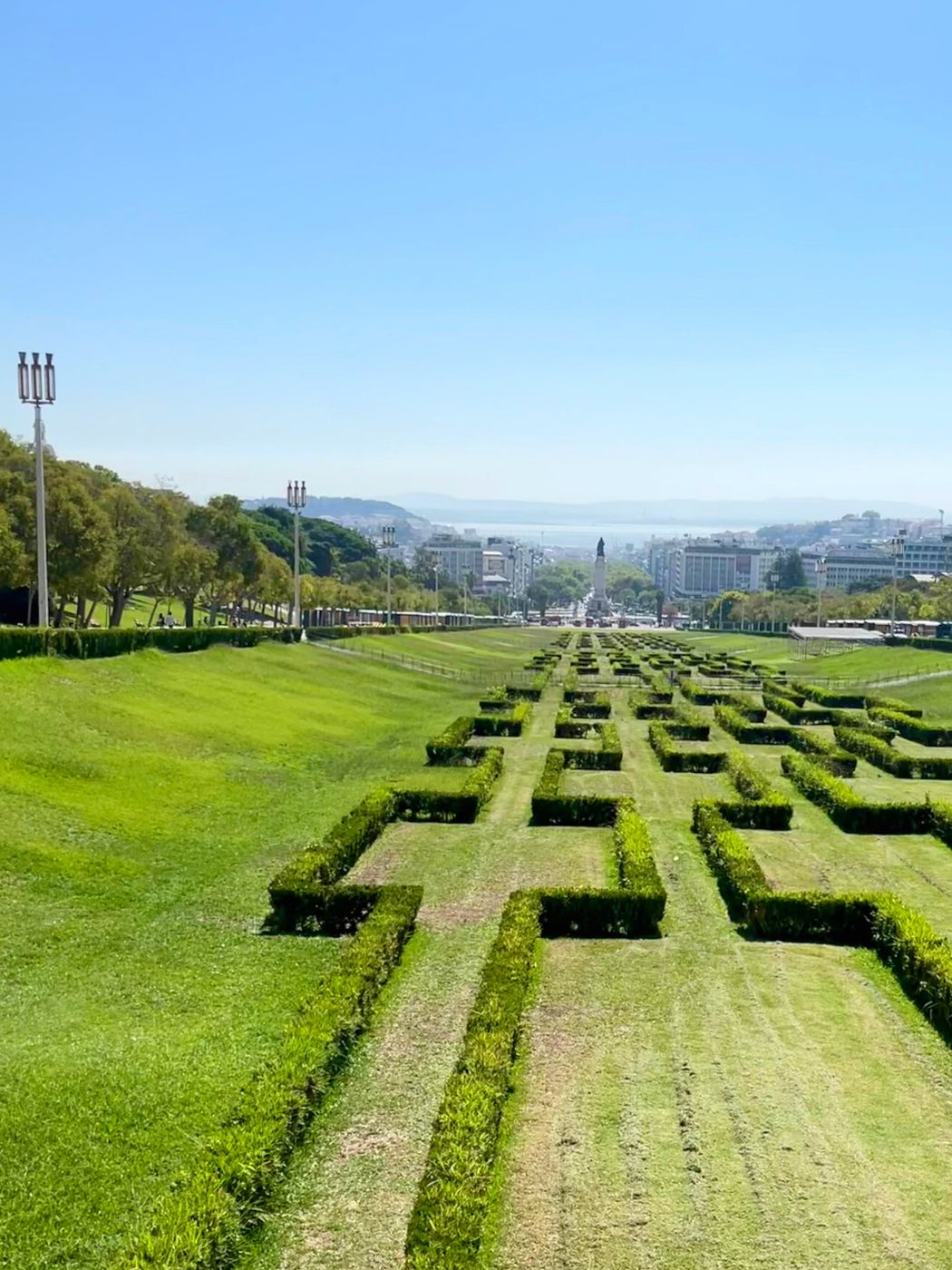
Viking offered two optional excursions for the afternoon, a food tour in the Campo de Ourique neighborhood, or a tour of the National Tile Museum. We went on the Flavors of Lisbon tour. The pleasant neighborhood did not feel touristy. Late 19th century Art Nouveau architecture lines the streets. Several buildings have azulejos façades. There were also many low-rise, pretty pastel colored apartments with ground floor shops and restaurants.
We sampled food at three small cafes; tapas at À da Bia aqui no Bairro and Cortesia then pastal de nata at A Tentadora. All felt like authentic local favorites. We ended the excursion at the Jardim da Parada. A green village square with a fountain, gazebo and several tables of older men playing cards. The food was good, nothing amazing, but what I enjoyed most was the smaller group you get with Viking’s optional excursions and the cool vibe of the Campo de Ourique neighborhood.
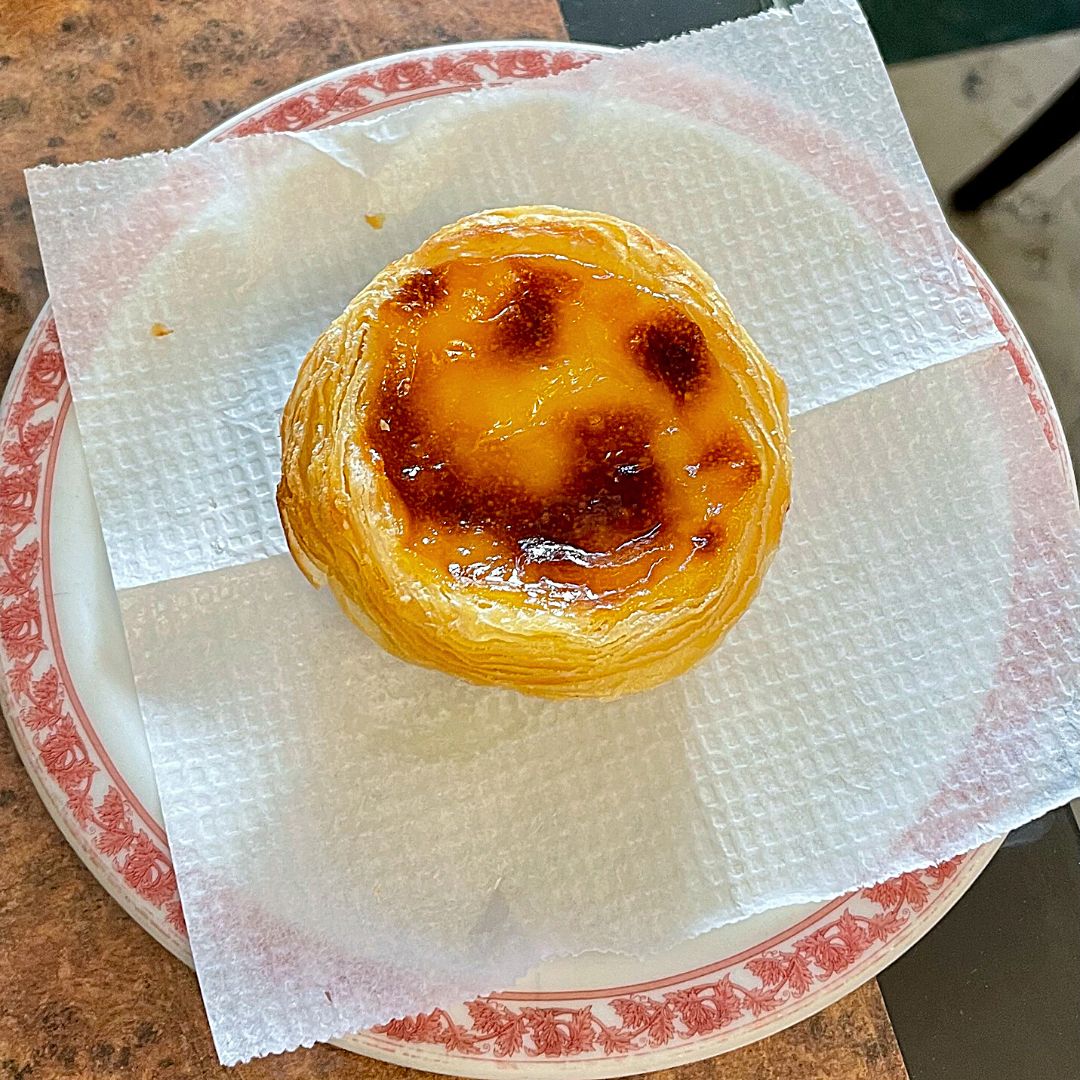
When on vacation one of my favorite things to do is rooftop bar-hopping. With all of Lisbon’s hills, it is the perfect city to enjoy drinks with a view. We ubered (yes, Lisbon has uber!) from our hotel to the Vintage. It’s a cozy, stylish smaller venue.

The V closed early for a private event, so we ubered to the Carmo Outdoor Terrace. Carmo Terrace was hopping with a DJ playing techno music. We sat next to the Santa Justa lift and watched the sunset over Alfama.
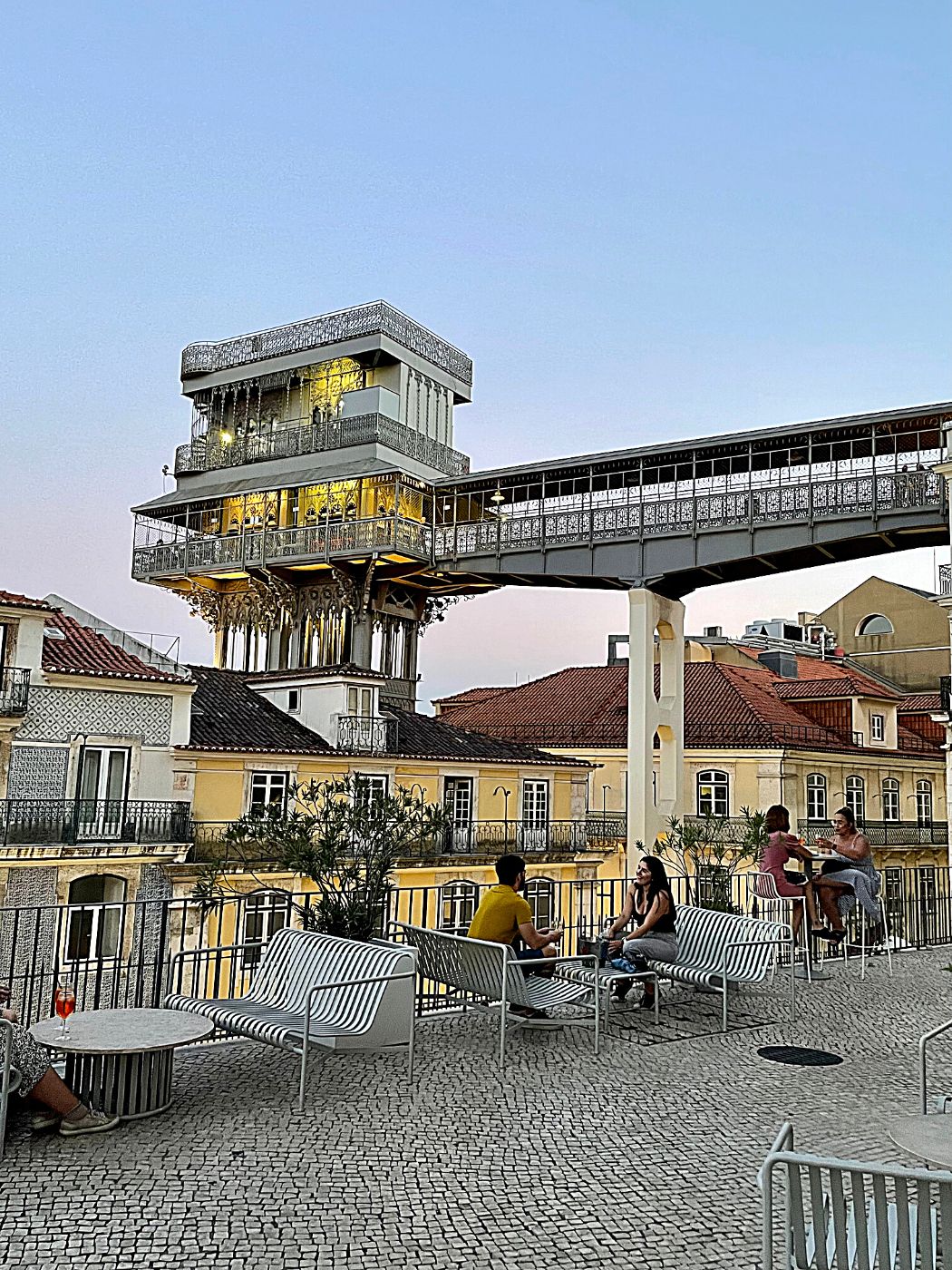
It was a whirlwind two days in Lisbon! There is so much to see and do. We walked down the terrace and through Rossio Square back to the Hotel Tivoli. Our next stops were the optional excursion to Batalha Monastery and Fatima then on to Porto to catch the Viking Torgil.
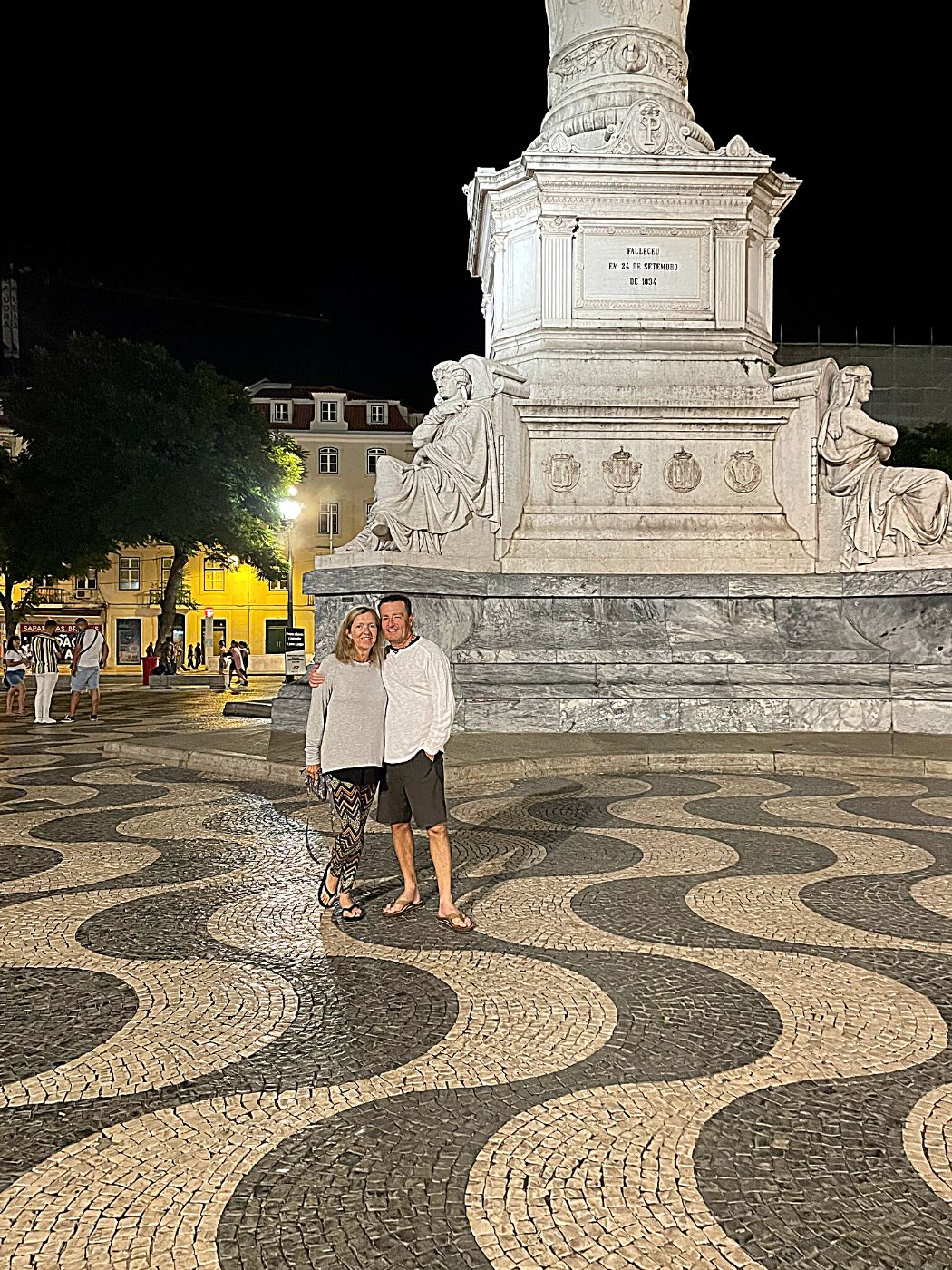
Some great suggestions for Lisbon, lovely post!
Thanks Cass! Nice to hear from you 🙂
This is nice! I do plan on visiting hopefully next year with my little monster, hubby, and my mom! Thanks for the info.
Thank you Dani! Lisbon is fabulous. I hope you have a great trip!
So many great places to see in Lisbon! You found some great viewpoints of the city!
Thanks Ashley! I wish I had even more time there!
Thanks Ashley! Lisbon a very photogenic city. 🙂
I love how good Lisbon looks, amazing pictures. Portugal is very high on my list, definitely saving this post for my visit.
Thanks Jamsmina! I hope you get there soon!
Love all the amazing architecture. The funicular car and pink street are so much fun too. Thanks for sharing your adventure. Going to save this for later. Hoping to visit one day!
The architecture in Lisbon really wowed me! I know you’ll get there one day 🙂
I love all of the photos. It looks like a great place to explore. I think I would buy one of those artist drawings outside the castle as a memento.
Thank you Jolayne:) I did pick up one of those canvases! It’s on a small easel in my study’s bookcase.